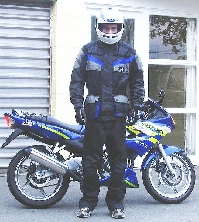Cold weather motorcycle gear for fall riding
By Catalogs Editorial Staff

Keep you warm and dry in cold weather motorcycle gear
Cold weather motorcycle gear can be the difference between a long ride and turning around. Riding in cold weather is extremely enjoyable, but you have to be warm, dry and protected from the weather.Though fall begins with temperatures in the seventies, the season also brings a chill that makes even the toughest riders shiver.
For riders, cold weather means it?s time for more layers. Your body is rather inactive when riding, so the right cold weather motorcycle gear is essential. Keep in mind that as fall weathers shift from cold, to freakishly warm, to frosty, you?ll need to adjust your layers so you don?t overheat or under dress. Most fall gear is designed so you can take off or add a layer if needed.
Layering your clothes for cold weather riding consists of three components: The inner, mid and outer layer. The inner layer?s job is to wick moisture. The mid layer provides insulation by trapping your body heat, and the outer layer blocks the weather and rain.
Cold Weather Motorcycle Gear from Head to Toe
Head
If you ride with an open face helmet, a balaclava will keep the cold out and help retain your body?s heat. If you wear a full face helmet, a balaclava may only be necessary in temperatures below 40 degrees. You can find balaclavas in the running or skiing sections of sporting goods stores. Balaclavas cover the back of your head, your neck and face leaving a hole for your eyes. Some designs have an adjustable cover for your mouth and nose that you can tuck beneath your chin in warmer weather.
Upper Core
A good base layer on your upper core is crucial. A long sleeve base layer shirt should fit snug to wick sweat from your body. Cotton t-shirts and underwear are not designed for this purpose. The best base layer materials are synthetics like polyester, lycra and rayon. If you go on long rides, choose a base layer designed for athletes for maximum moisture wicking capabilities. Wear a fitted t-shirt with long sleeves made from synthetic materials to trap and store your body?s heat and prevent you from getting cold. Remove the mid layer if you over heat while riding.
A water-proof jacket with a thin, lightweight liner serves two purposes: the inner liner traps heat to keep you warm in temperatures up to 30 degrees, while the outer layer will block rain and wind. A number of fall jackets have removable liners for warmer days when all you need is a base and mid layer with the outer jacket.
Lower Body
The best pants for cold weather riding are textile outer layer pants with zip-out liners. They provide warmth and versatility for changing fall weather. If temperatures drop below 25 degrees, look for ski pants for longer rides. Note that pants should cinch at your ankles to allow boots to slide over easily, preventing wind from going up your legs.
If you ride your motorcycle a short distance to work, you may want to consider a riding suit. Riding suits go on over your work clothes quickly, while proving a full layer of protection from the wind and retaining enough body heat to keep you warm.
Feet
Before putting on socks, sprinkle foot powder on your feet to minimize moisture and discomfort. As a base layer for your feet, socks should wick sweat. Choose a polyester blend that?s not too bulky. Look for long socks that pull beyond your ankle for extra protection from the cold.
~Gloves and Liners
Choosing a good pair of riding gloves is extremely important, not only for your warmth, but safety. Gloves must keep your fingers warm without limiting dexterity or grip. Thin glove liners wick sweat, but they must be firmly anchored to your glove or they could slip or bind. Go for a long, gauntlet style.
Remember, fingers are the hardest part of your body to keep warm. Gloves separate your fingers so they don?t exchange heat and the limited muscle movement while riding reduces circulation. Even a good pair of gloves won?t keep your hands warm for very long once temperatures drop below 40 degrees. Stop every hour or so for a hot cup of coffee or tea if your fingers feel cold or numb.
As winter nears, consider heated grips and gloves, socks, vests and pants. Known for draining batteries, heated clothing will continue to keep you warm enough to enjoy the road ahead. If you begin to shiver, don?t shake it off. Stop someplace warm. Shivering is your body?s way of telling you that you?re not dressed properly for the weather. Bring your core body temperature up and take regular breaks. Pay attention to your body, especially when you?re riding on a cold day.
References:
Rider Magazine
Revzilla: Textile Motorcycle Pants
Popular Savings Offers



.jpg)






.jpg)
